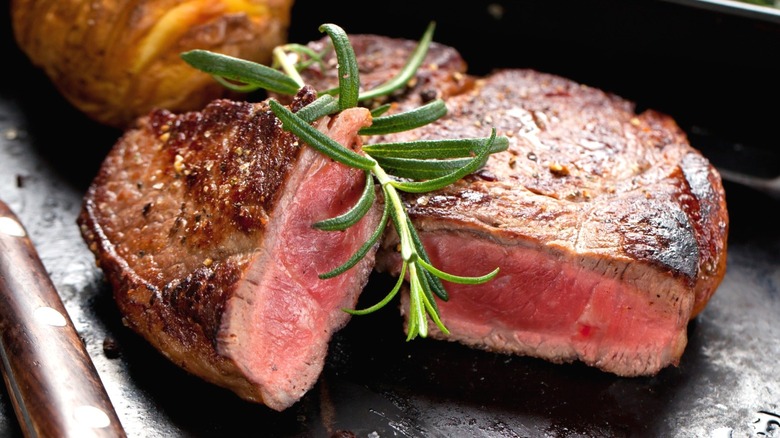The Flavorful Addition That Makes Restaurant Steak Taste So Good
Why does the steak you eat at a restaurant taste better than the steak you cook at home? This is a question many people have asked themselves, and there's a simple, if rather glib, answer: the chefs that staff restaurant kitchens cook for a living (while the rest of us likely do not). After all, they may have even gone to school specifically to train for it. But what techniques, exactly, elevate their delicious steaks above your meager pan sears? We asked Jeffrey Williams, executive chef at the DC restaurant Willowsong who told us to make use of some combination of fats and aromatics when searing steak to maximize flavor.
"We use all kinds of fats," Williams says, before adding that "it all depends on application." Depending on what you have planned for your meal, you might want to make use of "butter, duck fat, [or] tallow" when you sear your steak — to which you may add "shallot, garlic, and herbs." By searing and basting, you can impart both the unctuousness of the fat and the flavor of the aromatics onto your steak, whether it's a tender flat iron steak or Anthony Bourdain's beloved sirloin. That way, you don't need any fancy seasoning blends — although Williams says that "when cooking larger pieces he may do a spice rub" but will typically "primarily only season with salt."
You can still make great steak at home
If you assume that you'll never achieve restaurant-quality steak because you don't buy from their suppliers, Jeffrey Williams tells us that's not necessarily the case. "I think the quality of steaks a regular consumer can get is definitely the same as what we use in the restaurant," he says. It's not like there are secret grocery stores that sell all the prime beef, after all — you're able to buy it, too (although it probably won't come cheap). There's nothing stopping you from buying the world's most expensive caviar, either, aside from the fact that you may not have $25,000 to spare.
Is there anything else you need to make a great steak? According to Williams, not really. Although he mentions that techniques like sous vide (a cooking method that allows precise temperature control) and dry aging can elevate your cut of choice, he generally believes that "less is more" when it comes to making steak. "I think if you pay for a good steak, you let that steak shine and don't mask it," he said. That's why searing with fat and aromatics is so handy; instead of adding an overbearing flavor of its own, it boosts the steak's natural flavor and makes for a more satisfying experience.

